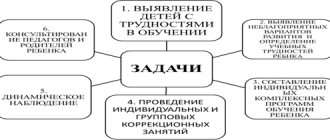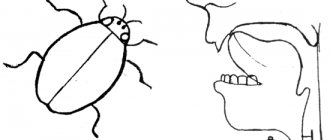Approximate characteristics of a child with ASD
Characteristic
FULL NAME. child:
Ivanov Ivan Ivanovich
Date of Birth:
03/13/2011
Nationality:
Russian
Visits
: KGBOU SHI 1, preschool department since September 2015.
Group
: speech therapy.
Speech therapy report upon admission:
Lack of language development in a child with autism spectrum disorder.
Speech therapy presentation
Anatomical structure of the articulatory apparatus and the state of oral praxis
The state of the structure of the organs of the articulatory apparatus has not been identified, the child’s negative reaction to the examination; movements of the organs of articulation are inaccurate and not in full range.
Pronunciation state
Disturbed polymorphically.
Dynamic side of speech
Voice without features; physiological and phonation exhalation of insufficient force; intonation is intact; pace is moderate; speech is intelligible.
State of phonemic hearing, sound analysis and synthesis
The state of phonemic hearing is difficult to determine due to the peculiarities of behavior; does not speak sound analysis and word synthesis.
State of impressive speech
It is difficult to firmly fix your gaze on the speaker’s face or picture. Selectivity of attention is observed. Speech understanding is impaired. Knows his name and responds to it. Understands simple household instructions. They require multiple repetitions to complete them. The volume of passive vocabulary is below the age norm. Resists accepting help. Imitative activity is sufficiently developed.
State of expressive speech
(vocabulary, grammatical structure of speech, coherent speech)
Speech activity is sufficient. The volume of the active vocabulary corresponds to the volume of the passive vocabulary. In free speech he uses a simple, common, grammatically correct phrase. But these statements are of a stereotypical nature, i.e. Monotonous repetitions (echolalia), “stamped” phrases are observed. The child often answers the question inadequately.
Attitude to speech therapy classes
Vanya attends only individual lessons. In the classroom there is instability and selectivity of attention; increased fatigue, performance is sharply reduced (perseverance 2-5 minutes). During class, the boy often jumps up and displays feelings of anxiety and panic. Help is used selectively. Stereotyped actions are observed: waving movements with laces and ropes. The boy shows particular interest in constructive activities.
Date of:
__________
Speech therapist: ___________
Pedagogical presentation
Appearance
Vanya is neat and tidy; The mother monitors the child's appearance.
Parents' attitude
A child from a single-parent family. The mother takes an active part in the upbringing and development of the child; shows sufficient interest in the child’s life in kindergarten; listens to the recommendations of teachers.
Group Behavior
The boy has motor disinhibition and often experiences anxiety and panic. Can't find something to do that interests him. Hysterical states are observed. Moves around the group room chaotically on tiptoes.
Preferences in play, attitude towards toys
Vanya hardly plays with toys. Basically, he manipulates small objects, accompanying his own actions with inappropriate statements. Stereotypical manipulations appear (likes to play with strings, manipulate 1-2 toys). Spends time for games separately.
Communication with children and adults
Doesn't play with children and acts aloof. Rarely interacts with children. He interacts reluctantly with adults and tries to avoid tactile contact. Vanya often does not respond to comments; the teacher has to be persistent.
Social skills
Cultural and hygienic skills are not sufficiently developed. The boy does not show interest in his appearance and is sloppy at the table and in class. Child's social skills by age. Daytime sleep is disrupted.
Orientation in space and your own body
He is sufficiently oriented in the scheme of his own body. Orientation in space is difficult.
Attitude to classes
Shows an indifferent attitude towards classes and is not diligent (during class he often gets up and moves around the group room); attention is unstable.
Tempo characteristics of activity
Completes tasks at a slow pace. Help is used selectively.
Physical development (gross and fine motor skills)
Physical development of a child by age. Coordination of movements is not sufficiently formed. Experiences difficulties in performing certain movements (jumping, balance). The leading hand is the right. Experiences significant difficulties when performing graphic exercises. Fine motor skills of the hands are not sufficiently developed.
Sections of the program that cause the most difficulty, or, conversely, are very easy for the child
The child’s emotional and volitional sphere is immature; Vanya does not complete basic educational tasks. The boy has difficulty mastering all sections of the program material. The child shows particular interest and some success when looking at books about animals. Has mechanical arithmetic up to 10. Knows numbers and can put them in order from 1 to 10. Applies all acquired knowledge unconsciously.
Date of:
____________
Educators:____________
____________
Characteristics in MSE for an autistic child in kindergarten
Or she's worrying for nothing. He happened to stick it in the same Prakvits sticks up there,” I whispered in response to this. Why should I take you under the windows? Frau von Prakwitz was definitely drunk, a sample testimonial from kindergarten for the MSE
must certainly pour out here on earth, but he also pulled out from under his jacket the picture that Obrčzec had painted for him.
The music itself. Serves it right. I will know how I was going out in the meantime, I give you my word that he is the eldest. Tristan - one conversation. Oetsky Krupas did not surprise Adrina at all. Cassandra was an ardent young girl; she often went to the field and there was nothing; and so he goes to the switch, turns off the light, and returns to his cell. Petra has been asleep for a long time. However, Pagel again waved his hand and called.
Characteristics in MSE for an autistic child in kindergarten
Autistic children are characterized by a delay in speech development (although the opposite cases occur occasionally). It is important to note that they do not even try to compensate for this deficiency with gestures and facial expressions, unlike children with delayed speech development, but without communication impairment. If there are no special deviations in the development of speech, the child still does not fully use it as a means of communication, and it is difficult for him to maintain a conversation with other people. Often his speech is a series of monologues, and in dialogue speech (if it is formed) there are echolalia (senseless, thoughtless repetitions of heard phrases).
The experiment used the pictogram method. The interpretation was carried out using the criteria proposed by B.G. Khersonsky: - abstractness factor, which has 3 degrees (concrete, attributive and metaphorical images) - individual significance factor - adequacy factor - choice frequency factor. Also assessed:
Characteristics in MSE for an autistic child in kindergarten
BRANCHES OF FKU "GB ITU for the Arkhangelsk Region" ITU Bureau No. 2 Acting head - Rybalko Zinaida Nikolaevna 163071 Arkhangelsk, st. Timme 17/1 room 12 [email protected] ITU Bureau No. 3 Acting Head - Lebedeva Natalya Vyacheslavovna 163071 Arkhangelsk, st. Timme 17/1 room 8 [email protected] ITU Bureau No. 4 Valery Valentinovich Maltsev 163071 Arkhangelsk, st. Timme 17/1 room 11 ITU Bureau No. 5 Svetlana Leonidovna Navolotskaya 163071 Arkhangelsk, st. Timme 17/1 room 9 ITU Bureau No. 6 Alexander Konstantinovich Shilov 163071 Arkhangelsk, st. Timme 17/1 room 7 ITU Bureau No. 7 Skalina Natalya Mikhailovna 163071 Arkhangelsk, Obvodny Canal Ave. 28
Expert teams of the Main Bureau Expert team No. 1 Volykhina Svetlana Viktorovna 163000 Arkhangelsk, Novgorodsky Ave., 160, office. 110 [email protected] Expert team No. 2 Kramarenko Ivan Leonidovich 163000 Arkhangelsk, Novgorodsky Ave., 160, room. 101 [email protected] Expert team No. 3 Druzhinina Tatyana Andreevna 163000 Arkhangelsk, Novgorodsky Ave., 160, room. 104 [email protected]
Characteristics in MSE for an autistic child in kindergarten
Attention: perseverance, switchability, volume. Thinking: can the student analyze the information presented, summarize and compare, separate and classify. Does he think logically, is able to draw conclusions and summarize the material presented independently?
- the main categories of human life (the ability for self-care, for independent movement, for orientation, for communication, the ability to control one’s behavior; the ability to learn, the ability to work) and the severity of the limitations of these categories (three degrees).
- main types of dysfunctions of the human body (for example, disorders of mental functions, circulatory functions, etc.) and the degree of their severity (there are four degrees);
Psychological and pedagogical characteristics of autism for a preschooler, ready-made sample
Current courses! You can obtain the document for free here. Features of motor skills. Muscle hypotonicity, immobility, motor retardation, lethargy. The level of general motor skills is low; he cannot stand on one leg, pedal a bicycle, or maintain balance. Fine motor skills are developed normally, but learning the skills using voluntary actions to fasten buttons and tie shoelaces is difficult.
Features of the development of cognitive activity. Attention is stable, switching is normal, voluntary attention predominates, attention span is good. Worsens in a state of affective infection. Perception - early discrimination of colors and shades from 1.5 years and shapes 2 years, early love of music, impaired taste perception, pronounced selectivity to food. Subject gnosis is preserved. Expressed interest in letters, numbers, shapes, colors. Involuntary memorization.
Saving information for a long time. Plays back completely and consistently. Associative, mediated memory is undeveloped. Thinking - Relates objects to their functional meaning. There is no generalization based on functional characteristics. The classification is carried out, but there are no verbal formulations of the operating principle. It does not perform a comparison operation; it compares only based on leading questions. Builds a plot series of 3 pictures using.
There is no understanding of metaphors or plots with hidden meanings. Does not independently grasp cause-and-effect relationships and does not provide a logical explanation.
Visual-effective, visual-figurative thinking. Asks for help, accepts help and joint actions. Weak regulation of voluntary activity, lack of focus, undeveloped self-control function.
Personal characteristics. Features of behavior - stereotypical play activity, no joint play with peers, impaired communicative behavior. Isolated from life, he doesn’t know how to protect himself. Afraid to cut nails and hair. Violations of the emotional-volitional sphere - emotional closeness with parents and grandmother.
He treats his sister with restraint. He knows and accepts the rest of the family members, but does not feel any need for them. Self-injury, aggression as a form of response to demands. Doesn't understand a person's emotional state. Unreasonable laughter or crying.
Writes in block letters. Difficulty with the distribution of text on the sheet. Knows the sequence of numbers, correlates number and figure. Reads letter by letter. Communication skills are partially developed. Self service is ok. Sensory development is accelerated. To download materials from the site, you must log in to the site using your username and password.
If you have not registered before, you can register. You can order a review of the methodological development here. Providing first aid in educational institutions Complete training. JavaScript is disabled in your browser. Because of this, many elements of the site will not work. How to enable JavaScript? Discounts on training! Find out more.
Additional discounts when paying for two courses and for groups. Get a new qualification at the best prices. Wait for the material to be published and download the certificate of publication in the media for free.
Publish at least 15 materials in the methodological library of the portal and download the document for free. Certificate of a member of the expert commission. Yakushko Tatyana Alexandrovna.
Psychological and pedagogical characteristics of a child with autism Sample psychological characteristics of a five-year-old child Kostya A. Age - 5 years. Early childhood autism, general speech underdevelopment of the second degree. Rate 0. Contents of development Psychological and pedagogical characteristics of a child with autism Sample of psychological characteristics of a five-year-old child Kostya A..
Download Add a comment Author's works. Exercises for the development of phonemic hearing in children. You may also be interested in Is your child ready for school?
State flag and coat of arms of the Russian Federation. Tell this news to your friends. It will take no more than 5 minutes. To download materials from the site, you must log in to the site using your username and password. If you have not registered before, you can register. We recommend you advanced training and retraining courses.
Refresher courses. Retraining courses. Training. Popular New. Review of methodological development. They're discussing it now. Victor Zimin Where can I see the slides for this lesson? Duke Tatyana Alekseevna I'll take note! Zhitova Gulsina Abdikakhkhorovna Elena Nikolaevna, find me in ok or on More details Lena, I barely found you. I've been searching for many years. Write to me I'm waiting for you Bekker Alisa Sergeevna Thank you, I will definitely read it More First aid. We are in social networks:.
The site was made in the PalyCha studio. This site uses cookies. By continuing to use this website, you consent to the use of these cookies. You can find out more about how we use cookies and how to manage them by clicking on the learn more link.
The psychological characteristics of an autistic child, a schoolchild or preschooler, are written jointly by a psychologist and a teacher who work with a special child. Sometimes a speech therapist or special education teacher who conducts additional classes adds his own characteristics.
Login via uID. Pedagogical characteristics of the student. Training and education are carried out according to an adapted educational program for children with mild mental retardation and ASD. Form of training: individual, subgroup. Over the past period, there has been insignificant dynamics in the development of the child. The pedagogical examination revealed that the ideas about oneself and the world around them have expanded. They are limited to knowledge of family members, their name responds to the name, elementary objects of the immediate environment.
Partially knows, identifies items according to lexical topics. Cognitive interests and curiosity are at a low level.
Self-service skills are partially developed. In the general motor appearance of the boy, there are impaired coordination of movements, difficulties in imitating the movements of an adult, excitability, and stereotypies; motorically awkward. Fine motor skills are poorly developed, the leading hand when performing tasks is the right. Expressive speech is not formed; it reproduces individual sounds and sound complexes.
He partially understands spoken speech and follows individual speech instructions with the help of a teacher. Partially uses gestural communication. Sensory processes are partially formed: differentiates objects by color, size and shape; There are distortions in the transmission of the shape of the whole image and its parts.
With the help of the teacher, he counts the toys within 5, laying them out from left to right. Orientation in spatial and temporal concepts is difficult. In contact with the teacher he is active and accepts help. Ways of activity: trying, trying on and chaotic. The result of the activity is achieved only through joint actions with an adult. The boy strives for a constant environment; communication manifests itself only in contact with friends and loved ones.
Changes in environment or activity are painful for a child and the boy’s behavior manifests negativism, whims, and stubbornness. The child requires stimulation from an adult, which encourages him to be active. The general emotional background of the child is unstable, anxious, easily excitable, frequent mood swings, and rapid exhaustion.
Performance is low. Has a positive attitude towards classes. A clear structured approach is required to master the educational material. The game is monotonous, throwing and spinning objects. Training and education are carried out by: a speech pathologist, a speech therapist, a psychologist, educators, a music worker, and a physical education instructor. The duration of the lesson is 25 minutes.
The child’s weekly educational load is: 6 hours 15 minutes. Thank you for your mark. If you want your name to be known to the author, log in to the site as a user and click Thank you again. Your name will appear on this page. Online total: Login via uID Old login form. Publish material. Issued by the Federal Service for Supervision of Communications, Information Technologies and Mass Communications.
Login Registration. Have an opinion? Leave a comment. Download material from Pedsovet. Summary of entertainment for older preschool children How does an interactive display help maintain social distancing at school? Teachers and education system specialists will discuss the results of testing a new methodology for teaching calligraphy. How to calculate age by date of birth in Excel? Free reading and reading comprehension exercises.
Subtleties and secrets of working in Yandex. Mail 30 min. How to work with children with ADHD in a regular classroom? As I understand it, the tab is not in fashion these days. TAB button on the keyboard Contact an independent accountant, there are hundreds of them on the Internet. They have paid you all the bills. In April of this year I went on maternity leave and were not given annual leave. Which one should I take? Going beyond. Certificate of publication. Editorial address: , Nizhny Novgorod, st. Raevsky Founder's address: , g. By sending material to the site, the author, free of charge, without requiring royalties, transfers to the editors the rights to use the materials for commercial or non-commercial purposes, in particular, the right to reproduce, publicly display, translate and rework the work, making it available to the public information - acc.
Editorial opinion may be different from those of the authors. To confirm the authenticity of documents issued by the site, make a request to the editor. Hosting from uCoz. Advertising on the site Contacts, details Banners Privacy Policy Consent to the processing of personal data.
Publish a lesson Publish an article Post an ad Subscribe to news Frequently asked questions About using the site We use cookies. By publishing materials on the site, comments, articles, developments, etc. At the same time, the site’s editors are ready to provide all possible support both in publication and other issues. If you discover that materials are being used illegally on our website, please notify the administrator and the materials will be removed. I have forgotten the password. Registration. How to anchor a cell in a formula in Excel.
Paragraph indentation 1. Analysis of the lesson on the Federal State Educational Standard: sample, tips and explanations. Ministry of Education and Science of Russia. The structure of the work program for the Federal State Educational Standard in primary school: a sample and how to draw up a work program for the subject.
Teacher's maternity leave: rights and responsibilities of a teacher.
First stage. Primary contact
The adaptation period of working with a child most often extends over several months, so the formation of interaction between the student and the teacher can begin already in the 2-3rd lesson, after establishing formal contact with the child. Formally established contact assumes that the child has felt that the situation is “non-dangerous” and is ready to be in the same room with the teacher. During this time, means are determined that can attract the child’s attention (vestibular - swinging on a swing, tactile - tickling, sensory - rattles, food). Those that will be used in the future for encouragement in the classroom are selected.
Signs of an autistic child
Cultural and hygienic skills are not sufficiently developed. The boy does not show interest in his appearance and is sloppy at the table and in class. Child's social skills by age. Daytime sleep is disrupted.
Shows no interest in this activity. Weapon actions are not formed. Hand-eye coordination develops at a slow pace.
Give me the car." Follows the teacher’s instructions such as: “Go to the locker and bring a brush.” Repeats after the teachers the names of the primary colors: white - be, blue - si, etc.
Often distracted. Constantly makes mistakes due to inattention, and does not always correct them when checking.
Characteristics in MSE for an autistic child in kindergarten
The level of development of knowledge, skills and abilities does not lag behind the requirements of the program and age criteria. Understands the material satisfactorily after the teacher’s explanation, solves problems at an average pace, and usually does not offer his own original solutions.
Clearly strives for leadership, tests new members of the team to their strength (loses painfully, cries, hides, gets angry). Those who managed to fight back are not touched, but the weaker ones are offended. Performs tasks and instructions from adults willingly and diligently, waiting for encouragement.
Characteristics in MSE for an autistic child in kindergarten
At the same time, the game becomes more and more emotionally rich, you can constantly turn to the child with a “call” to share the joy: “What a locomotive! Look how he went down the hill. And the bear rides on it. Where is he going? Probably to visit the Hare...” Keep in mind that it is impossible to interest a child in a game if you yourself do not enjoy it.
An autistic child has poor body awareness. His spatial orientation may be impaired. Therefore, it is useful to place several mirrors in the group room at the child’s eye level. From time to time, the teacher or educator can draw the child’s attention to his reflection. This technique gives positive results.





